Experience affordable ceramic coating Sarasota for an ultra-glossy look.
A Comprehensive Guide to the Kinds Of Ceramic Finishing on the marketplace
Ceramic layers have actually emerged as a pivotal remedy across various sectors due to their unique residential or commercial properties and applications. As we discover the distinctive features and applications of these layers, the ramifications for efficiency and longevity end up being progressively noticeable, elevating questions concerning which type might ideal match your requirements.
Understanding Ceramic Coatings
Ceramic finishings are innovative safety solutions that have actually gotten appeal in various sectors, especially in automobile and aerospace applications. These coatings consist of a liquid polymer that, when healed, develops a sturdy, hydrophobic layer on the surface of the substratum. This layer offers boosted resistance to ecological pollutants, UV radiation, and chemical exposure, consequently extending the life and aesthetic charm of the underlying product.
The essential element of ceramic finishings is silica, which adds to their solidity and resilience. The application procedure normally includes surface prep work, application of the covering, and healing, which can be achieved with warmth or UV light. Once cured, ceramic coatings exhibit extraordinary bonding properties, allowing them to adhere strongly to a range of surface areas, including metals, plastics, and glass.
Along with their safety attributes, ceramic finishings also offer convenience of maintenance. Their hydrophobic nature minimizes the adherence of dirt and gunk, making cleansing easier and less constant. In general, the adoption of ceramic coverings stands for a substantial development in surface protection innovation, giving both functional and visual advantages throughout several sectors.
Sorts Of Ceramic Coatings
Various sorts of ceramic coatings are offered, each designed to fulfill details efficiency requirements and applications - ceramic coating sarasota. One of the most typical types include:
Silica-based Coatings: These finishings mostly include silicon dioxide and are known for their longevity and chemical resistance. They are extensively utilized in automobile and industrial applications.
Titanium Dioxide Coatings: Popular for their photocatalytic homes, titanium dioxide finishings are frequently applied in environments where self-cleaning and antifungal homes are preferable, such as in building materials and vehicle finishes.
Zirconia Coatings: Characterized by their high-temperature stability and thermal resistance, zirconia coatings are utilized in applications such as generator engines and high-performance automobile components.
Alumina Coatings: Exhibiting excellent firmness and thermal security, alumina finishes are often made use of in wear-resistant applications, consisting of reducing tools and commercial machinery. - Car Detailing
Hybrid Coatings: Integrating the residential or commercial properties of various materials, hybrid finishes offer improved performance features, making them suitable for distinct and demanding applications.
Each kind of ceramic layer offers distinctive functions, permitting users to pick one of the most appropriate remedy based on specific environmental problems and efficiency needs.
Advantages of Ceramic Coatings
Ceramic finishes, in specific, deal many benefits that make them increasingly preferred among producers and customers alike. These finishes are immune to scrapes, chemicals, and UV rays, guaranteeing that the underlying surface area continues to be secured over time.
In addition to resilience, ceramic finishes offer excellent hydrophobic buildings, enabling for simple cleansing and maintenance. This water-repellent nature reduces the adherence of dirt, gunk, and other impurities, which can extend the visual allure and performance of the surface area. Moreover, ceramic layers can dramatically enhance thermal resistance, making them suitable for applications that sustain high temperature levels.

Application Refine
When applying Paint Protection Film ceramic coatings, a careful strategy is necessary to achieve optimum outcomes. The application process commonly starts with thorough surface area preparation. This includes washing, decontaminating, and polishing the surface to get rid of all contaminations, including dirt, oil, and prior waxes or sealants. A clean surface area guarantees proper adhesion of the coating.
As soon as the surface is prepped, the following step is to use the ceramic coating. This can be done utilizing an applicator pad or a microfiber cloth, ensuring even coverage. It is vital to work in little areas to preserve control and avoid premature curing. The coating must be applied in slim layers, as thicker applications can lead to unequal surfaces.
After application, the layer requires a specific healing time, usually ranging from a few hours to a complete day, depending on the product. During this moment, it is vital to prevent direct exposure to dampness or pollutants. Finally, a gentle buffing may be required after curing to improve the gloss and remove any high areas. Following these steps diligently will maximize the performance and durability of the ceramic covering, providing a durable protective layer for the surface.
Upkeep and Durability
To make certain the durability and effectiveness of a ceramic covering, normal upkeep is important. Ceramic finishes, understood for their toughness and protective high qualities, call for certain care routines to optimize their lifespan and efficiency. The learn the facts here now first action in maintenance involves routine cleaning with pH-neutral soap, avoiding rough chemicals that can weaken the coating. It is suggested to wash the automobile frequently, ideally every two weeks, to stop the build-up of contaminants that could compromise the finish's stability.
In enhancement to routine cleaning, routine assessments are vital. Look for signs of wear or damage, such as hydrophobic homes decreasing or surface area flaws. If required, a light gloss may be used to renew the coating without stripping it away.
Additionally, the application of a booster spray can boost the coating's hydrophobic results and restore its gloss. This is especially beneficial for finishes that have actually remained in usage for an extensive duration. Eventually, by sticking to these maintenance methods, one can considerably prolong the life of a ceramic finishing, guaranteeing that it proceeds to provide ideal protection versus ecological variables and keep the aesthetic allure of the car.
Conclusion
